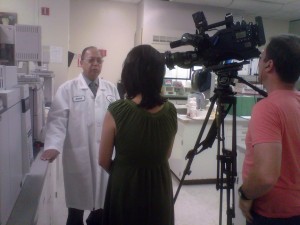Spinach had sand kicked in its face five years ago during a nationwide E. coli contamination episode, but it has come back stronger than Popeye’s biceps.
“It’s basically back to where it should be,” said Steve Koike, plant pathology farm adviser with the Salinas-based U.C. Cooperative Extension Office for Monterey County.
The September 2006 E. coli bacterial outbreak killed three women and caused more than 200 illnesses in 26 states and Canada. The outbreak caused the shutdown of spinach harvesting for about two weeks in the Salinas Valley while federal and state health officials tried to determine the source of the contamination.
After a lengthy investigation, the officials fingered Dole-brand bagged baby spinach processed at a San Juan Bautista plant. That plant was operated by Natural Selection Foods LLC and the spinach likely came from a Mission Organics field in Paicines, officials concluded.
During the outbreak, the U.S. Food and Drug Administration warned consumers not to eat fresh spinach until the outbreak source was found — making it the first time a whole class of leafy greens had been deemed too dangerous to eat by government officials.
Before the outbreak, spinach brought in more than $188 million in gross revenue into Monterey County. In 2010, the latest year for which figures are available, spinach was worth about $128 million, according to the Monterey County Crop Report produced by the county Agricultural Commissioner’s office.
Those in the know in the vegetable industry say there has been a sea change in the way greens are grown, harvested and processed now compared to before the outbreak. They attribute it to the California Leafy Greens Marketing Agreement adopted in 2007.
That agreement, crafted by the industry and overseen by government auditors, mandates that all handlers who sign the agreement accept produce only from growers following stronger safety guidelines.
“There has been really a cultural shift, if you will, on food safety on the farm,” said Joe Pezzini, chief operating officer of Ocean Mist Farms in Castroville. “There is a heightened sense of food safety on the farm there has been a real commitment by the industry that the best food safety practices are being followed.”
Pezzini was the face of Salinas Valley growers in the wake of the contamination. In 2006 and 2007 he was the chairman of Grower — Shipper Association of Central California and from 2007 until 2010, he chaired the California Leafy Greens Marketing Agreement (CLMA) group.
The 1998 food safety guidelines that were in place were too general, said Pezzini, who noted that government auditors have done hundreds and hundreds of safety audits since 2007. The new practices established since the contamination include field workers now wearing gloves and hair nets, sanitizing of harvesting knives in chlorine and monthly testing of water sources, he said.
“These are all new practices that became the standard in the industry since 2007,” he said. “It’s all about risk assessment; it’s assessing the risk of the potential contamination.”
The practices adopted under the marketing agreement are dynamic, and standards can be changed, Pezzini said.
“These are practices that will evolve over time with new science, new research.”
Spinach is just one of 14 vegetables covered under the agreement. The others are arugula, butter lettuce, chard, escarole, iceberg lettuce, red leaf lettuce, baby leaf lettuce, cabbage (green, red and savoy), endive, green leaf lettuce, kale, romaine lettuce and spring mix.
“From the public’s perception, we would want them to know we have a program in place that the best safety practices are being followed on the farm,” Pezzini said.
He called the leafy greens document the first of its kind: “It’s become a model for other programs.” The tomato industry has looked into adopting a similar agreement in
other states, Pezzini said.
Improving produce safety is an ongoing issue, said Bonnie Fernandez-Fenaroli, executive director for the Center for Produce Safety at U.C. Davis.
“A lot of research is going into all produce right now.”
The center has 54 produce safety projects under way, she said. The center was established in 2007 as a private-public partnership with $2 million coming from the Produce Marketing Association. Taylor Farms California Inc. of Salinas kicked in another $2 million for research, said Fernandez-Fenaroli.
Christine Bruhn, a food marketing specialist and director of the Center for Consumer Research at U.C. Davis, said recent surveys show consumers are more concerned
about meat products but 30 percent said they are concerned about produce safety.
“We advise people to wash their sink and their hands, then wash produce in running water and dry with a clean paper towel,” Bruhn said by email. “This reduces but
does not eliminate bacteria.”
Scott Horsfall, the CEO for CLMA, said the industry used the 2006 tragedy as “a stepping stone” for food safety. The biggest accomplishment is “the way the
culture has changed on the farm — food safety is No. 1 for everyone involved.”
The leafy greens agreement used six elements to address the contamination problem. As listed on the organization’s website, they include assessing risks,
applying science, verifying compliance, providing corrective actions, promoting transparency and documenting practices.
U.C. extension microbiologist Koike gives the industry credit for being aggressive after the contamination in forging the leafy greens agreement. “Food safety is not a
new issue,” he said. As for spinach, Koike said, “It’s very safe, but there’s no such thing as zero risk.”
The produce safety center looks at how to reduce health risks in the products and where the pathogens come from that produce illness-causing bacteria, said
Fernandez-Fenaroli. A pathogen is any “agent that causes disease, especially a living microorganism such as bacterium or fungus,” according the Free Online
Dictionary website.
Experiments showed that E. coli “applied to soil or spinach leaves demonstrated the pathogen does not survive well under in-field environmental conditions.” That
finding was one of “Twelve Key Learnings.”
The finding clearly shows “the importance of performing risk assessments on fields prior to harvest” because it may be more important to identify “potential
contamination” closer to harvest times, researchers said. “Association with organic materials in the soil seems to aid [E. coli] survival.” More research in this area will be
important, according to the website.
There were 22 outbreaks of E. coli connected with the consumption of leafy green vegetables in California from 1995 through 2006, according to the CPS website.
Steps the produce industry has taken to reduce the likelihood of food contamination originating from leafy greens include keeping both wild and domestic animals
out of the fields, said consumer marketing expert Bruhn.
“Absolute safety, however, is not guaranteed, because bacteria are part of the natural environment, and there are some pathogens out there,” she said.
“Currently there is a recall on cantaloupe grown in Colorado and there have been other recalls this year as well.”
The climb back to respectability for spinach has been a long, slow process, Pezzini said: “It’s probably taken the spinach industry five years just to get back
to where they were.” But the goal is to provide consumer confidence. “These are the products [vegetables] the government tells you you should be eating,”





